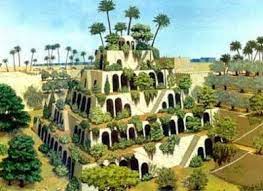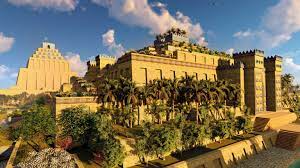Today’s modern scientists and archaeologists, who do not understand the magnificent structures of ancient times, count them as one of the wonders of the ancient world. The mysterious Hanging Gardens of ancient Babylon was one such hoax. Since ancient times, experts have been curious to know how these gardens, known as the Hanging Gardens of Babylon (present-day Iraq), could have been grown on multi-story terraces without soil and how they hang without roots going into the earth.

What is unique about them ?
These hanging gardens have been included in the seven ancient wonders of the world. Although those mysterious hanging gardens have only been mentioned in the ancient remains, to date the archaeologists digging there have not been able to find the remains of the garden matching this description.
But there was such a miraculous garden, there are written records of its existence, and historians are unanimous that these hanging gardens were indeed there. The Hanging Gardens of ancient Babylon were described in ancient writings as a wondrous achievement of technology with its climbing series of multi-level gardens with a variety of trees, wonderful shrubs, and graceful vines. It was so huge that it looked like a whole green mountain.

Origin of garden
It is popular about these gardens that they were built by King Nebuchadnezzar II to please his wife, Queen Amytis, who was the princess of the country of Media. It is said that Queen Emitis was often sad and depressed in her palace, missing the green hills and valleys of her kingdom.
Emperor Nebuchadnezzar II (Nebuchadnezzar II) built a wonderful structure in the form of Hanging Gardens and also built a grand palace named “The Marble of Mankind” to please the queen.
King Nebuchadnezzar II ruled Babylon for about 43 years, from about 605 BCE to 562 BCE. Assyrian civilization was ruling in Babylon at that time.
Nebuchadnezzar II was a powerful emperor of the Assyrian civilization. His father, Nabopolassar, was an official in the newly created Assyrian Empire of the late Middle Ages, who declared himself emperor of the entire Assyrian Empire around 620 BC and took over the reins.
It is said that the reign of his son, Emperor Nebuchadnezzar II, was one of the golden ages of the Assyrian civilization. The earliest description of the Hanging Gardens of Babylon comes from a writing by Berossus, a Babylonian priest, in 290 BC.

Other descriptions
Diodorus Siculus, a Greek historian, described them as saying that it was a square garden 400 feet long and 400 feet wide and it was situated at a height of about 60 meters. According to Diodorus, large trees were given sufficient depth at their base to develop the root, and the gardens were irrigated from the nearby Euphrates River. In such a situation, the arrangement of irrigation by taking water from the river to that height is also wonderful.
Due to the unavailability of documents from the Babylonians at the time of its construction, it is not clear whether the Hanging Gardens were actually a construction or just a mention in the legends.
Other Believes
Archaeologists believe that these gardens may have been south of Baghdad in Iraq and were destroyed due to the continuous wars going on in Iraq since ancient times. While some other experts believe that these gardens were destroyed due to a terrible devastating earthquake that occurred two centuries before Christ.
Between 1899 and 1917, Robert Koldewey, a German archaeologist, discovered gardens similar to the Hanging Gardens described by Diodorus Siculus to the south of Baghdad. But, after 18 years of research, Stephanie Daly of Oxford University has concluded that these gardens may not have been in the south of Baghdad but in northern Mesopotamia (Iraq) and they may have been built by the Assyrians who settled there.
Other interpretation
These included a large variety of large trees, herbs, and vines. This interpretation of Stephanie is also strengthened by the fact that documents have been found in the Assyrian kingdom to have magnificent gardens on high walls. In the fort of the Assyrian emperor Sennacherib, canals have been cut through the mountains, due to which irrigation is possible on high places and terraces.
Mystry at present
Due to this technology, it would have been possible to grow lush green gardens even in the dusty hot summer season. This system produces such a wonderful artistic effect that it was many times better than the system of its predecessors. This irrigation system is a great example of water engineering. Many pictures of these gardens from the time of Emperor Sennacherib are preserved in the British Museum but they are not displayed but why this is also a mystery. Don’t know what they want to hide ! That is why most of today’s historians and archaeologists consider the trees and plants grown on the high walls and towers of the Assyrian emperor Sennacherib’s fort as hanging gardens, but these too have now been destroyed.
Hanging Garden is the only one among the seven wonders, whose definite evidence has not yet been found. There can also be a possibility that in reality these gardens never existed. In the past two decades, both Babylon and Nineveh have suffered greatly from wars and looting, and with everything destroyed by this terrible devastation, it does not seem likely that this mystery will be fully solved anytime in the future.

Also Read:
Erichthonius – The Strange Son of Athena and Hephaestus
